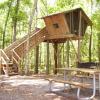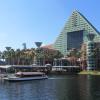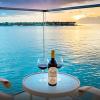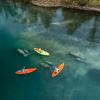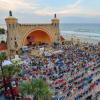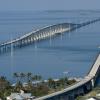Jeff Klinkenberg
A rooster crows in the distance. A palm tree sways. A tourist hands me his camera in front of a concrete marker on the corner of Whitehead and South Streets.
For the record, I am taking the photograph at 24 degrees 33 minutes north latitude and 81 degrees 45 minutes – it’s supposed to be the Key West southernmost point of the continental United States, though some argue it really isn’t. We like to argue in Key West.
At dawn, tourists begin lining up for pictures next to the red, white and black buoy that marks the southernmost spot. At sunset the line still snakes down the block, though this being Key West, most tourists have traded their coffee for something boozier.
“I always wanted to come here,’’ Baltimore’s Eric Scott tells me on one of those balmy mornings for which Key West tourists pay plenty. “It’s cool to be this far south.’’
When I was a boy, my dad played piano at a honky tonk somewhere on Duval. During the day we fished from the seawall at the southernmost point.
It was a crowded place back then, too, but more commercial. I remember seeing the African-Bahamian Julian “Yankee” Kee, who peddled grunt and snapper, lobster and conch shells from a worn out card table. After the old man died, I remember seeing his grandson, Albert, a preacher known in Key West as the Bishop, famous for waving to tourists and blowing on a Conch shell as if it were Louis Armstrong’s trumpet. That part of the southernmost point is gone now, though a bronze statue of the Bishop tells the old history.
Key West's southernmost point is located in an old Key West neighborhood, where residents sometimes stand in their yards and behold the passing humanity. One time I stopped to chat with Rita Castillo, who told me about the favorite conversations she’d had with tourists excited to be at the southernmost spot in the continental U.S.
“Which direction is Cuba?’’ someone asked her.
“South. Ninety miles away,’’ Rita answered.
“I can’t see anything but ocean,’’ complained the tourist.
“To see Cuba you would have to have vision better than 20/20,” Rita explained.
Ah, Key West.
When you go…
Southernmost Point
Whitehead Street and South Street, Key West, FL 33040
(305) 809-3700
60 Seconds in Key West and The Florida Keys
60 Seconds in Key West and The Florida Keys
FREQUENTLY ASKED QUESTIONS
Q: Why is Key West called the "Southernmost Point" of the continental U.S.?
A: Key West hosts the famous Southernmost Point Buoy, which designates the southernmost point on the continental United States. It's only 90 miles to Cuba, so it is the closest U.S. city to the island. This brightly colored concrete buoy is a must-take photo opportunity and represents Key West's special geographical and cultural standing.
Q: How are the Florida Keys different from the rest of Florida on the mainland?
A: The Florida Keys are a coral cay archipelago that stretches over 120 miles southwest of the mainland. They boast a subtropical climate, clear turquoise water, extensive coral reefs (including the only living coral barrier reef in the continental U.S.), and laid-back island culture. All of this makes the Keys an international-class location for snorkeling, diving, fishing, and boating.
Q: When is the best time to visit Key West and the Keys?
A: High season is November to April when the weather is dry, temperatures are mild (70-80°F average), and humidity is lower. The summer months are warm, humid, with higher hurricane risk but with smaller crowds and lower rates.
Q: What are a few of the most popular attractions in Key West?
A: Don't overlook the Ernest Hemingway Home and Museum, vibrant Duval Street for nightlife and shopping, Mallory Square's Sunset Celebration, and the Key West Butterfly and Nature Conservatory. Watersports like snorkeling in the surrounding coral reefs and to Dry Tortugas National Park are musts as well.
Q: How far is Key West from Miami and how do I get there?
A: Key West is about 160 miles southwest of Miami. The drive along the Overseas Highway (U.S. 1) is about 3.5 to 4 hours and consists of 42 bridges connecting the islands. Alternatively, there are shuttle services, flights from Miami International Airport, or ferrying from the mainland.
Q: What wildlife is unique to the Florida Keys and Key West?
A: The Keys are home to threatened species like the Key deer, a smaller subspecies of white-tailed deer that is found only in the Lower Keys. Sea life ranges from manatees and sea turtles to brightly colored coral reef fish. Bird watchers can spot birds like the roseate spoonbill and osprey.
Q: Are the Florida Keys prone to hurricanes? What do visitors need to know?
A: Yes, the Keys are prone to hurricanes, especially from June to November, the Atlantic hurricane season. Travelers should remain aware of weather forecasts, be ready for travel itineraries that are flexible, and be acquainted with evacuation routes. The majority of hotels and businesses have rigorous hurricane readiness plans.
Q: Can I visit Dry Tortugas National Park from Key West?
A: Yes. The Dry Tortugas National Park, 70 miles west of Key West, is accessible by ferry, seaplane, or private boat. It boasts historic Fort Jefferson, excellent snorkeling, and picturesque beaches. It's a remote and unspoiled area offering a one-of-a-kind island adventure.
Q: What is the weather like in Key West and the Florida Keys year-round?
A: The Keys have a tropical savanna climate with warm temperatures year-round, from 75°F winter highs to 90°F summer highs on average. Rainfall is usually limited to the wet season (June to October), typically in short, heavy showers.
Q: Are there any special cultural or historical events in Key West?
A: Yes. Key West hosts lively events like Fantasy Fest (an annual 10-day Halloween carnival), Hemingway Days (celebrating the author's legacy), and the Key West Lobsterfest. The island's multicultural origins manifest themselves in festivals and local cuisine, a fusion of Caribbean, Cuban, and southern Florida influences.




